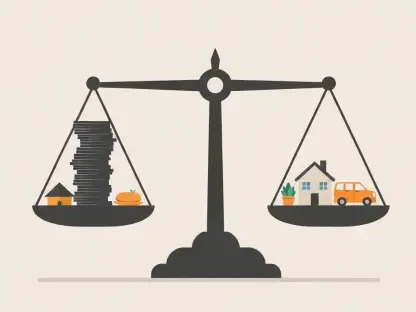The U.S. Federal Reserve (the Fed) plays a crucial role in shaping the nation’s economic conditions, including the landscape for mortgage rates and borrowing costs. Through its monetary policy actions, the Fed influences various facets of the economy, which in turn affect the interest rates on financial products that consumers rely on, including mortgages. This article will delve into how these monetary policies translate into tangible outcomes for borrowers.
The Fed’s Role in the Economy
The Federal Reserve is tasked with managing the U.S. monetary policy to ensure economic stability. One of its primary tools is to adjust the federal funds rate, a key interest rate at which banks lend money to one another overnight. This rate is pivotal as it indirectly sets the borrowing costs across the economy.
Federal Funds Rate and Economic Tone
Adjusting the federal funds rate sets the tone for the cost of borrowing money. For instance, during 2022 and 2023, the Fed raised this rate multiple times to curb soaring inflation. Although the federal funds rate doesn’t directly control mortgage rates, it significantly impacts economic conditions that do. Higher federal funds rates generally lead to increased costs for consumers and businesses to borrow money.
The ripple effects of the Federal Reserve’s actions are multifaceted. When the central bank decides to increase the federal funds rate, the repercussions are felt across various sectors. Businesses looking to expand find borrowing more costly, which can slow down job creation and investment. On the consumer side, higher interest rates on credit cards, personal loans, and auto loans become apparent, tightening household budgets. This often results in reduced consumer spending, which can dampen economic growth. Conversely, when the Fed reduces the federal funds rate, borrowing becomes cheaper, encouraging spending and investment, which can stimulate economic growth. In either scenario, these shifts set the stage for fluctuations in mortgage rates, influenced by broader economic conditions.
Open Market Operations and Liquidity
The Fed uses open market operations to buy and sell debt securities. When the Fed buys securities, it injects liquidity into the financial system, lowering interest rates across the board. Conversely, selling securities constrains liquidity, raising interest rates. This affects interest rates for loans, including mortgages, as part of the Fed’s broader mandate to stabilize financial markets and enhance the flow of credit in the economy.
The mechanisms through which open market operations impact mortgage rates are intricate but pivotal to the Fed’s strategy. When the Federal Reserve purchases Treasury securities, it is essentially increasing the money supply. This is because the sellers of these securities now have more cash at their disposal, which increases the overall liquidity in the banking system. More liquidity typically means that banks have more funds to lend, which puts downward pressure on interest rates, including those for mortgages. Conversely, when the Fed sells these securities, it pulls liquidity out of the system, reducing the funds available for lending and pushing interest rates higher. Thus, the open market operations play a crucial role in adjusting the broader financial environment, making it more or less expensive to secure a mortgage.
Factors Influencing Mortgage Rates
Understanding how mortgage rates are set involves recognizing the multiple factors that come into play, often influenced by the Fed’s actions but not directly controlled by them.
Treasury Yields and Mortgage Rates
Mortgage rates, particularly for fixed-rate loans like the 30-year fixed mortgage, are closely tied to the yield on the 10-year Treasury bond. This bond yield serves as a benchmark, meaning that when these yields go up, mortgage rates often follow. The relationship is indirect but important: the economic conditions influenced by the Fed’s rate decisions can push Treasury yields up or down, thereby affecting mortgage rates.
To delve a bit deeper, the 10-year Treasury bond is considered a low-risk investment, so its yield reflects the broader sentiment about economic stability and inflation. When investors are confident about economic conditions or are worried about rising inflation, they tend to demand higher yields on these bonds. Higher yields on the 10-year Treasury bonds indicate that the returns on safer investments are increasing, pushing up the rates on riskier, longer-term loans like mortgages to remain competitive. Meanwhile, during periods of economic uncertainty or low inflation, investors flock to the safety of Treasury bonds, driving yields down, which in turn can result in lower mortgage rates. Consequently, the Fed’s policies, by influencing broader economic stability and inflation, play a pivotal role in determining the benchmark Treasury yields, which then affect mortgage rates.
Market Dynamics
What impacts the gap between Treasury yields and mortgage rates? It often boils down to inflation, supply and demand dynamics, and investor behavior. When inflation rises, long-term fixed interest rates, including those for mortgages, typically increase. Similarly, if there’s high demand from consumers for mortgages, lenders may raise rates to manage this interest.
Supply and demand in the mortgage market morph due to various reasons. When mortgage rates are low, more people seek loans to purchase homes, leading to increased demand for mortgages. Lenders, seeing the high demand, might increase rates to temper the interest and ensure they can manage their lending capacity effectively. On the flip side, during periods of low demand, perhaps spurred by high rates or economic uncertainty, lenders might lower mortgage rates to attract more borrowers. Additionally, inflation expectations can change rapidly, affecting long-term interest rates. If lenders expect inflation to rise, they might preemptively increase mortgage rates to offset the anticipated loss in purchasing power. These market dynamics, therefore, combine with the baseline set by Treasury yields to determine the final mortgage rates offered to consumers.
Investor Behavior and Secondary Markets
Many lenders sell their mortgages bundled into mortgage-backed securities to investors. When demand from investors for these securities is high, mortgage rates are lower because lenders can offer cheaper loans. However, in times of low demand, rates increase to attract investors. The Fed’s policies, influencing broader market conditions, can thus affect investor behavior and mortgage-backed security demand.
This aspect introduces another layer of complexity into the mortgage rate-setting process. Mortgage-backed securities (MBS) provide lenders an avenue to free up capital, allowing them to issue more loans. When investors, including large institutional entities like pension funds or hedge funds, show a strong appetite for MBS, they are essentially providing a steady stream of capital for lenders. In such scenarios, lenders can afford to offer lower mortgage rates because they can offload these loans in the secondary market more easily. Conversely, when the appetite for MBS wanes, perhaps due to higher perceived risks or lower returns compared to other investments, lenders must increase mortgage rates to compensate for the higher risk and make these securities attractive. Therefore, the interplay between the Fed’s economic policies and investor behavior in the secondary market forms a crucial link in understanding mortgage rate fluctuations.
Impact on Adjustable Rate Mortgages (ARMs)
While fixed-rate mortgages get a lot of attention, adjustable-rate mortgages (ARMs) are also heavily influenced by Fed policies. Unlike their fixed counterparts, ARMs have variable interest rates that adjust periodically.
SOFR and ARMs
ARMs often use the Secured Overnight Financing Rate (SOFR) as a benchmark, which is directly influenced by the federal funds rate. When the Fed changes the federal funds rate, ARMs that are tied to SOFR will typically adjust their rates accordingly during the reset period. This makes ARMs more sensitive to the Fed’s monetary policy actions than fixed-rate mortgages.
Because ARMs pivot on the SOFR, any alterations in the federal funds rate quickly ripple through to these mortgage products. The SOFR is reflective of overnight borrowing costs in the broader financial system, which is directly impacted by the Fed’s rate decisions. When the federal funds rate is increased, the SOFR follows suit, leading to higher rates on ARMs during their next adjustment period. This can significantly alter the monthly payments for borrowers, especially in a rising interest rate environment. Conversely, when the federal funds rate is reduced, the SOFR decreases, potentially lowering ARM rates and easing the financial burden on borrowers. Hence, those with ARMs need to pay close attention to the Fed’s monetary policy shifts, as these decisions have immediate and direct consequences on their mortgage costs.
Rate Resets and Borrowing Costs
Borrowers with ARMs must be mindful of rate resets. When the federal funds rate goes up, so does the interest on ARMs during their adjustment periods. This can lead to higher monthly payments, making it important for ARM holders to stay informed about potential Fed rate changes and their implications.
The rate reset periods are particularly crucial for ARM borrowers. These are predetermined intervals, often annually, when the interest rate on the mortgage can change based on the current SOFR. In a rising rate environment, this can result in a substantial increase in monthly mortgage payments, catching some borrowers off guard. It’s imperative for ARM holders to track economic indicators and Fed announcements to anticipate these changes. Moreover, understanding the terms of their mortgage, such as rate caps that limit how much the interest rate can increase during any single adjustment, can provide some clarity and preparedness. Borrowers might also strategize to refinance into a fixed-rate mortgage during periods of favorable interest rates to mitigate the unpredictability associated with ARM resets.
The Path to Lower Borrowing Costs
For borrowers, understanding how to navigate the landscape shaped by the Fed’s monetary policy can make a significant difference in securing favorable mortgage rates.
Credit Scores and Debt Management
One of the most effective strategies for obtaining a lower mortgage rate is maintaining a strong credit score. Lenders view borrowers with excellent credit as less risky, often offering them better rates. Additionally, minimizing existing debt can make a borrower more attractive to lenders and improve the chances of securing a lower interest rate.
A robust credit score typically signifies to lenders that a borrower is financially responsible and capable of managing their debt effectively. Regularly servicing debt obligations, avoiding high credit utilization, and maintaining a clean repayment history are key components of building and maintaining a strong credit score. Borrowers should also be cautious of taking on new debt in the lead-up to applying for a mortgage, as this can negatively impact their credit profile. Minimizing existing debt not only improves creditworthiness but also lowers the debt-to-income ratio, a critical metric lenders use to assess a borrower’s ability to manage new mortgage payments. By staying financially disciplined and proactive, potential homeowners can significantly enhance their chances of securing more favorable mortgage terms.
Down Payments and Shopping Around
Making a sizable down payment can also improve borrowing conditions. Lenders may offer better rates to borrowers who are willing to invest more upfront. Moreover, comparing different mortgage offers is crucial. Each lender has its parameters and considerations, so shopping around can help borrowers find the most competitive rates and terms.
A substantial down payment reduces the loan-to-value ratio (LTV), which measures the loan amount relative to the property’s value. A lower LTV signifies less risk for the lender, often resulting in more attractive mortgage rates for the borrower. Furthermore, dedicating time to shop around among various lenders can uncover significant differences in loan offers. Mortgage brokers, banks, and credit unions may offer distinct terms based on their risk assessments and financial strategies. By soliciting multiple quotes and comparing the Annual Percentage Rate (APR), which encompasses the interest rate and additional fees, borrowers can ensure they select the most cost-effective mortgage option. This comprehensive approach to both upfront investment and diligent comparison shopping paves the way for optimal borrowing conditions.
Beyond Interest Rates: The Importance of APR
When evaluating mortgage offers, borrowers should also consider the Annual Percentage Rate (APR). The APR includes the interest rate and additional fees, offering a more comprehensive understanding of the loan’s total cost. This allows borrowers to make more informed decisions.
Understanding the APR is crucial as it captures the true cost of borrowing, beyond just the nominal interest rate. The APR accounts for additional charges and fees associated with the mortgage, such as origination fees, discount points, and closing costs. Therefore, even if two mortgage offers have similar interest rates, the APR can reveal differences in the overall expense involved, potentially guiding borrowers toward a more affordable option. It’s advisable for borrowers to scrutinize these charges and inquire about any ambiguous fees to avoid unforeseen costs. Grasping the complete financial commitment associated with a mortgage empowers borrowers to make decisions that align with their long-term financial well-being.
Conclusion and Final Takeaways
The U.S. Federal Reserve, often referred to as the Fed, holds significant influence over the nation’s economic conditions, particularly impacting mortgage rates and overall borrowing costs. By implementing various monetary policy actions, the Fed sets the stage for how different sectors of the economy perform, directly affecting the interest rates on financial products that consumers depend on, including mortgages.
When the Fed adjusts its policies—like changing the federal funds rate—it indirectly influences the rates that banks charge each other for overnight loans, which trickles down to affect consumer loan rates. For instance, when the Fed raises rates to curb inflation, borrowing costs for mortgages generally increase. Conversely, when it lowers rates to stimulate economic growth, mortgages become more affordable.
These policy shifts have tangible consequences for borrowers. Higher mortgage rates can make homeownership more expensive, reducing the demand for homes and potentially cooling the housing market. On the flip side, lower rates can make it easier for people to buy homes, spurring housing market activity.
The ripple effect of the Fed’s decisions extends beyond just mortgage rates. Credit card interest rates, auto loans, and other forms of borrowing also adjust in response to the Fed’s monetary policy. Understanding the Fed’s role and its policy choices is crucial for consumers aiming to navigate the ever-changing landscape of borrowing costs effectively.









